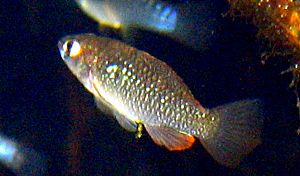Rainwater killifish facts for kids
Quick facts for kids Rainwater killifish |
|
|---|---|
 |
|
| Conservation status | |
| Scientific classification | |
| Synonyms | |
|
The rainwater killifish (Lucania parva) is a small, shiny fish. It has yellow hints and scales shaped like diamonds. You can find this fish along the coast from Massachusetts all the way to Mexico. They often live in large groups where fresh river water mixes with salty ocean water. Rainwater killifish eat tiny crustaceans, mosquito larvae, small worms, and mollusks. They can grow to be about 62 mm (2.44 inches) long.
Contents
What Does the Rainwater Killifish Look Like?
The rainwater killifish is a small, silvery fish. Its body is a bit flat from side to side. It has a small mouth that points slightly upwards. This fish is easy to spot because of its large scales. Each scale has a faint dark outline around it.
These fish have a somewhat chunky body. Their dorsal fin (on the back) and caudal fin (tail fin) are rounded. Their back is olive-colored. Their sides are silvery-blue, and their bellies are yellow. Male fish have fins that are dusky orange to yellow. These fins have a thin black edge, except for the pectoral fins (on the sides). Males usually have a black spot on the front of their dorsal fin.
What Do Rainwater Killifish Eat?
Rainwater killifish mostly eat tiny crustaceans. These include small copepods, which are like tiny shrimp. They also enjoy other small invertebrates. This can include brine shrimp and amphipods, which are small, shrimp-like creatures.
Where Do Rainwater Killifish Live?
The rainwater killifish is naturally found in coastal waters. Its home stretches from Massachusetts down to Tampico, Mexico. You can often find many of them in places where fresh water meets salty ocean water. These areas are called estuaries. They like calm waters with lots of plants. They usually swim a few inches below the water's surface.
This fish is very tough. It can live in many different levels of saltiness. It can survive in slightly salty water and even in very salty ocean water.
Reproduction and Life Cycle
In Texas, female rainwater killifish start getting ready to lay eggs in February. Some females are full of eggs by July. The busiest time for them to lay eggs is in May and June.
During spawning, the male and female fish swim into plants with fine leaves. Here, the female releases her eggs, and the male fertilizes them. The eggs have sticky threads. These threads help the eggs attach to the plants.
A male fish will swim in loops slightly below the female to court her. He waits for her to stop swimming. Once she stops, the male moves under her. He gently flicks his head against her throat. The pair then slowly moves towards the water's surface. The male keeps rubbing his head against the female's underside. When they are near the surface, the female swims into fine-leaved plants or clumps of algae. The male follows her.
Freshly laid eggs are round and almost clear. They have threads on their surface. Live eggs are about 1.23 mm across. The eggs hatch in about 6 days if the water temperature is around 23.9 degrees Celsius. A single female fish can lay more than one group of eggs in a year.
Where Are Rainwater Killifish Found?
These fish are native to coastal areas. They live from Massachusetts all the way to Tampico, Mexico. They have also been introduced to other places. These include California, Nevada, Oregon, and Utah. They are very common in the lower Pecos River area in New Mexico. However, they do not swim far up the smaller streams that flow into the river.
See also
In Spanish: Lucania parva para niños


